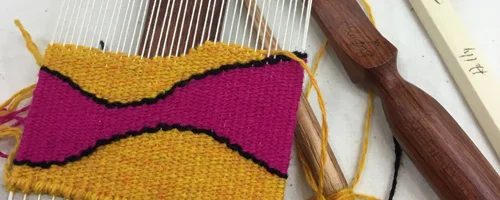The Cameron Peak Fire burned 326 square miles near my home in 2020.* It started August 13th and was finally declared controlled in January of 2021. All four of the trails I backpacked prior to August 13th in 2020 burned in the fire as did every other trail near home on my hiking bucket list. The forest is closed in most of the burn area and likely will remain so for a very long time as the dangers to people, the land, and the watershed are many. Regeneration will happen but the fire burned very hot in places and the soil was destroyed. That means things won’t grow back there any time soon and that soil will erode and negatively impact our water supply and the habitat of everything that lives near this zone.
If you followed me during the worst months of the fire, you know how much grief the loss of these places in the form I knew them brought up for me. I wove four small tapestries about the fire and will probably weave more in the series. These are small 3 x 3 inch tapestry diary pieces. All four are woven as if I’m standing in the same place looking at the same mountain in the Rawah Wilderness. But they could represent any of the hundreds of miles of trail that existed in the burn area.
The first two I wove on the same warp. The initial weaving was from an image I took on a hike just north of where the fire started. I took this image on my birthday which was August 5th. As I left the wilderness the next day, I distinctly remember thinking, 4 days in this wilderness wasn’t long enough, but I’ll be back soon. Less than a week later, the Cameron Peak Fire started in a place I could have seen from where I took this image. (Not all of the Rawah burned. The beginning of the trail to get to this place burned but I don’t believe the spot where this photo was taken did. This tree may still be standing and since it is probably many hundreds of years old, I hope it is. One day when it is safe, I will go and check.)







